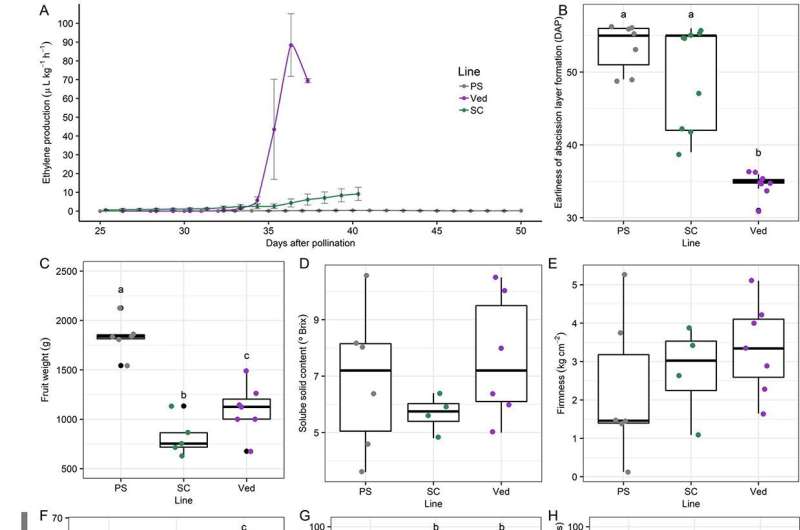This article has been reviewed according to Science X's editorial process and policies. Editors have highlighted the following attributes while ensuring the content's credibility:
fact-checked
peer-reviewed publication
proofread
Study integrates key genetic factors to enhance melon quality and aroma

Fruit development, particularly ripening, is a crucial and energy-intensive stage in plant life, vital for both human consumption and plant breeding. It involves biochemical and physiological transformations, such as cell wall softening and pigment accumulation. Melon (Cucumis melo L.), with both climacteric and non-climacteric varieties, is gaining attention as a model for studying fruit ripening processes, aided by genetic resources like Recombinant Inbred Lines and sequenced genomes.
Recent research has identified key Quantitative Trait Loci (QTLs) influencing melon ripening, such as ETHQB3.5, ETHQV6.3, and ETHQV8.1. These QTLs affect ethylene production and other ripening characteristics. However, the interaction among these QTLs and their collective impact on melon ripening and fruit quality remains an unexplored area of research.
In June 2022, Horticulture Research published a research article titled "Modulating climacteric intensity in melon through QTL stacking."
The parental lines used in this research showed varied ripening behaviors and fruit qualities. The PS variety produced a low ethylene amount, indicating a non-climacteric nature. Songwan Charmi (SC), though non-climacteric, exhibited some climacteric traits, such as aroma production. Védrantais (Ved, climacteric) displayed typical climacteric fruit ripening, with a sharp ethylene peak and noticeable climacteric traits. In terms of fruit quality, PS produced the largest fruits, while SC had the smallest. However, no significant differences were observed among the lines in terms of soluble solid content or firmness.
The aroma profile analysis revealed that Ved accumulated the most volatile organic compounds (VOCs), followed by SC, and PS the least. The diversity of VOCs was also highest in Ved. The study then developed Introgression Lines (ILs) in the PS background with various combinations of the QTLs.
Analysis showed that these ILs influenced climacteric symptoms such as earliness of aroma production and abscission layer formation. The ethylene production in these lines varied, with those containing more than one QTL showing earlier and higher ethylene production. ETHQV6.3 and ETHQB3.5 have significant effects on the earliness and sharpness of ethylene peaks, respectively.
Although ETHQV8.1 has no significant effect on ethylene peaks, it enhances the effects of the other two QTLs. The ILs also demonstrated significant increases in total volatiles production, particularly in esters, and varied in their production of other minor compounds like alcohols and terpenes. Interestingly, while the ILs generally mirrored Ved in floral and fruity aroma compounds, they did not significantly alter other fruit quality traits like weight, sugar content, or firmness.
In conclusion, this study successfully combined three QTLs—ETHQB3.5, ETHQV6.3, and ETHQV8.1—in the non-climacteric melon variety Piel de Sapo to modulate climacteric ripening and associated traits and elucidated the roles and interactions of them.
The approach demonstrates how genetic manipulation can finely tune fruit characteristics, paving the way for developing melons with varied shelf lives and aromatic qualities, enhancing their commercial and consumer appeal.
More information: Miguel Santo Domingo et al, Modulating climacteric intensity in melon through QTL stacking, Horticulture Research (2022). DOI: 10.1093/hr/uhac131
Journal information: Horticulture Research
Provided by Plant Phenomics




















